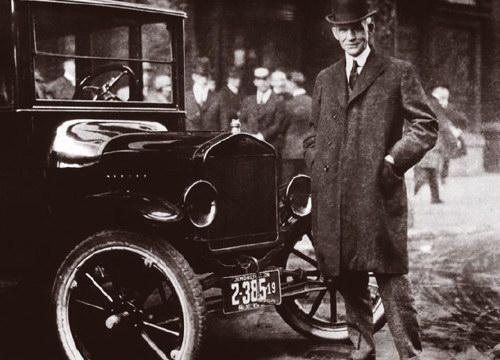When Cars Fly 当汽车会飞
2016-05-14ByIanBogost卢青亮/译注
By Ian Bogost 卢青亮/译注

The automobile has long been a symbol of everything great and everything terrible about America. On the one hand: freedom, individualism, power, speed. The taming1 of millions of miles of varied wildernesses through roads, then highways, then interstates. The capacity of American industry—Pittsburghs steel, Akrons rubber, Detroits factories.2
But on the other hand: gas-guzzling SUVs3. Traffic and sprawl4. The abandonment of mass transit. The suburb and then the exurb, with their undeniable ties to white flight and segregation.5 The decline of the Rust Belt, the near-collapse of the Big Three automakers during the Great Recession of 2008,6 and the slow death of American manufacturing and blue-collar work.
Now, after four decades of doldrums7, things are looking up for American carmakers, in ways that would have been hard to imagine just 10 years ago. Yet the changes ahead wont reconcile the great and the terrible of the past; instead, the conflicts between freedom and community, power and equity, will play out in new ways. Heres what that future will look like.
1. Baby Steps Toward Autonomy ...
Google, Tesla, and Uber—companies that didnt even exist when Toyota introduced the Prius,8 in 1997—have become major players in the auto industry. Both Google and Tesla aim to introduce fully autonomous cars within the next several years, and Uber recently founded an R&D center in Pittsburgh with an eye toward ushering in our driverless future.
Self-driving cars are expected to be much safer than human-driven ones. But even if the first robot cars hit the roads in the next few years, most of us probably wont give up driving entirely for at least another 15 or 20 years. In the meantime, traditional cars will gradually take over certain aspects of driving.
Companies have been adding semiautonomous features to cars since the 1990s—things like adaptive cruise control, which uses sensors to adjust a cars speed based on the traffic in front of it, and automated parallel parking. Some cars automatically stop—or at least slow down—if a driver doesnt step on the brake in time to avoid a collision. The driver will also be able to change lanes simply by hitting the turn signal for two seconds (the car will take care of the rest). Within a few years, cars may be able to determine when an accident is likely and make adjustments to the cabin—moving seats, closing windows, retracting the steering wheel.
2. ... And Big Leaps
While traditional manufacturers slowly add semiautonomous features, Tesla is taking a more aggressive approach. Last year, an update to the software in certain Model S vehicles added the ability to operate via “autopilot”: The car mostly drives itself, but the driver can take over if, for example, the car attempts to exit the freeway unbidden9. Each time a driver intervenes, Tesla registers the correction in its software, which is distributed across its fleet. The idea is that over time, the cars will get better at driving.
Early this year, Tesla updated its software again to add a way to “summon” your car. The car can turn itself on, open the garage door, and meet you in the driveway like an automotive butler10. For now, the feature is meant to be used only on private property, but Tesla promises Knight Rider11-style summoning in the future: Your car will greet you at the airport when you return from a trip or sync with your calendar and know where to pick you up after a meeting downtown.
3. Cars That Talk to One Another
Apps like Waze12 already allow drivers to alert others to traffic jams or accidents. Soon, cars will automatically contribute to a shared mesh13 of traffic and routing information through vehicle-to-vehicle communication systems. In addition to providing better traffic reports, these systems—through which cars will constantly transmit their location, speed, and other data—are expected to make driving much safer. If a driver brakes suddenly, or makes a blind turn, the car will issue a warning to others nearby to help them avoid a collision. The NHTSA14 expects vehicle-to-vehicle communications to result in significantly fewer accidents each year.
4. The Car as Conference Room
Once cars become fully autonomous, they wont need to take the form they have for more than a century. One concept design is the Mercedes-Benz15 F 015, which transforms the vehicle into a “digital living space.” Inside, seats swivel16 to face one another, and a series of displays permit passengers to entertain themselves or work. In other words, cars could double as conference rooms—and employers may begin to demand that people use their commutes17 productively.
Autonomous cars work best as fleets rather than as private property, because a car that can drive itself can be put to use even when you arent in it, and the tech companies making them prefer to sell services rather than products. Eventually, car ownership could become a thing of the past.
That would mean an end to the pride and personalization of owning a car. Not to mention living with one. Perhaps the garage, that great cornerstone of suburban architecture, will become a relic. Likewise parking spaces and lots, freeing up valuable real estate for greener and denser urban living. Your children might give as little thought to the kind of car they ride in as you do to the brand of subway train you take.
5. Where Are the Flying Cars?
Flying cars have been part of our science-fiction dreams ever since Henry Ford18 pitched an early personal airplane back in 1926—Fords aircraft division actually tried to build a “Model T of the air.” Ninety years later, discarded prototypes19 litter junkyards and collectors garages, but no viable mass-market product has ever emerged.
That might still change. The latest candidates include Skycar, a flying-car prototype, and the Ehang 184, an autonomous electric quadcopter20 introduced at the 2016 Consumer Electronics Show, in Las Vegas. In 2013, a company called Terrafugia announced plans for a self-flying car; it expects to have a prototype ready for testing by 2018. A commercial21 model will take at least another five years.
When they do arrive, flying cars will likely cost at least several hundred thousand dollars. They may replace the Lamborghini or the Bentley as the status car of the super rich.22 But for most of us theyll remain a dream, even if not a science-fiction one.
汽车长久以来一直象征着美国所有伟大和糟糕的东西。一方面,它象征着自由、个人主义、力量与速度。(汽车的出现使)数百万英里各种各样的荒地先后被开垦成道路、高速公路以及州际公路。汽车也象征着美国工业的产能,比如匹兹堡的钢铁、阿克伦的橡胶,以及底特律的工厂。
但不好的一面是:高耗油的SUV汽车、交通问题与城市的无序扩张、公共交通的弃用、近郊与远郊的先后出现及其同“白人群飞”和种族隔离无可辩驳的关系、“铁锈地带”的衰败、2008年经济大萧条期间三大汽车巨头的几近倒闭,以及美国制造业和蓝领工作的缓慢终结。
如今,历经40年的萧条之后,美国汽车制造业的情况有所好转,而且是以10年前想都不敢想的方式。然而,未来的改变并不会和过去的伟大与糟糕相协调;相反,自由与集体、权力与平等之争将会以新的方式上演。下面就是未来的景象。
1. 小步迈向自动驾驶……
谷歌、特斯拉以及优步(这些公司在丰田1997年推出普锐斯时还不存在)已经成为汽车行业的主要玩家。谷歌与特斯拉计划在几年内推出全自动驾驶汽车,而优步最近在匹兹堡成立了一个研发中心,朝着无人驾驶的未来望去。
自动驾驶汽车预计会比人工驾驶汽车更加安全。但即使未来几年第一批自动驾驶汽车开始在马路上出现,我们大部分人至少还要过15或20年才会彻底放弃自己驾驶。而与此同时,传统汽车还将逐渐占据驾驶的某些特定领域。
20世纪90年代以来,很多汽车公司就一直在给汽车添加半自动化功能,比如自适应巡航控制(这套系统根据车辆前面的交通状况,通过传感器来调整车速)和自动平行泊车。如果驾驶员没有及时踩刹车来避免碰撞,有些车会自动停下或至少是减速。驾驶员也可以简单通过打两秒钟转向灯来变道(汽车会自动解决剩下的事情)。不出几年,汽车也许可以预判事故的发生,并且对车舱做出调整,比如移动座椅、关窗和收起方向盘。
2. ……然后大步向前
在传统制造商慢慢给汽车添上半自动功能的同时,特斯拉则采取了更加积极的举措。去年,该公司对部分Model S车型进行了软件升级,添加了通过“自动驾驶仪”驾驶的功能:汽车在绝大部分时候自动驾驶,但是在特定情况下驾驶员可以取回掌控权,比如汽车未经许可试图驶出高速公路。每次一有驾驶员介入,特斯拉就会在软件中记下这次修正,并传送到整个车队。其理念就是:随着时间推移,汽车的驾驶技术会越来越好。
今年年初,特斯拉再次更新软件,加入了“召唤”功能。汽车可以自行发动,打开车库门,并在车道上等候,就像一位汽车管家那样。目前,这一功能只打算应用于私家车上,但是特斯拉承诺未来会有电影《霹雳游侠》中那样的唤车功能:汽车会在你旅行归来时去机场接机,或者通过与你的日程同步,知道在你到市中心开会后去哪里接你。
3. 会互相交谈的汽车
诸如“位智”之类的应用软件已经可以让驾驶员互相警告堵车和事故。很快,汽车将自动通过“车对车”通信系统来共享交通和道路信息。除了提供更高质量的交通报告,这些系统(汽车会通过系统持续传输其位置、速度和其他数据)有望让驾驶变得更加安全。如果某个驾驶员突然刹车,或者转弯时没有打灯,汽车将向周边汽车发出警告以免发生碰撞。美国高速公路安全管理局预计“车对车”通信可以大幅降低每年事故的发生。
4. 汽车变成会议室
一旦汽车实现全自动驾驶,那么汽车将不再需要以其已经延续了一个多世纪的样子存在。梅赛德斯-奔驰F 015概念车将汽车变成了“数字化的生活空间”。车内座椅可旋转成面对面的形式,一系列显示屏可供乘客娱乐或者工作。换句话说,汽车可以同时当做会议室来用,老板可能会开始要求员工把通勤时间高效利用起来。
自动驾驶汽车最好是以车队而非私人财产的形式运营,因为能够自动驾驶的汽车可以在车主离开的时候也投入使用,而且生产这类汽车的技术公司更愿意销售服务而非产品。最终,汽车所有权会成为历史。
这就意味着有辆车不再是骄傲与个性化的资本了,更别说和车住在同一屋檐下了。也许作为近郊建筑伟大基石的车库会成为遗迹,停车位和停车场也是一样。宝贵的不动产由此解放出来,以适应更为环保、更为紧凑的城市生活。你的孩子或许很少会考虑他们搭乘的是哪种汽车,正如你很少会考虑你搭乘的地铁是什么品牌。
5. 飞行汽车在哪里?
自亨利·福特1926年推出早期的私人飞机之后(福特的飞机部门事实上试图要创建“空中的T型车”),飞行汽车就一直存在于我们的科幻梦里。90年后,被抛弃的原型机被扔在垃圾场和收藏家的仓库里,但是可向大众销售的产品从未出现过。
这一情形可能有所转变。最新的产品包括Skycar(一种飞行汽车的原型)以及亿航184(于2016年拉斯维加斯消费电子展推出的一种自动电子四轴飞行器)。2013年,一家名为特拉弗吉亚的公司宣布了制造自动飞行汽车的计划,预计到2018年制造出测试模型,而推出可供销售的型号至少还需要五年。
当飞行汽车真的来临之时,售价可能至少需要数十万美元。它们也许会取代兰博基尼或者宾利成为超级富豪的身份象征。但对我们大部分人来说,它们仍然是个梦想,尽管不再是个存在于科幻里的梦想。
1. taming: 开垦,开辟。
2. Pittsburgh: 匹兹堡,位于宾夕法尼亚州西南部,曾是美国著名的钢铁工业城市,有“世界钢都”之称;Akron: 阿克伦,位于俄亥俄州东北部凯霍加河畔,20世纪20年代初期成为“世界橡胶之都”;Detroit: 底特律,是密歇根州最大的城市,曾经是辉煌的工业城市,有“汽车之城”的美誉。
3. SUV: 全称是Sport Utility Vehicle,即运动型多用汽车。
4. sprawl:(城市)杂乱无序的拓展。
5. exurb: 远郊;white flight: 白人群飞,指为了躲避有色人种,白人如同候鸟群飞一样,纷纷搬到有色人种住不起的郊区;segregation: 种族隔离。
6. Rust Belt: 铁锈地带,指的是美国中西部五大湖附近,传统工业衰退的地区;the Big Three automakers: 三大汽车巨头,此处指通用(General Motors)、福特(Ford)和克莱斯勒(Chrysler)。
7. doldrums: [复] 停滞,萧条。
8. Tesla: 特斯拉汽车公司(Tesla Motors),是全球豪华智能电动汽车行业的领导品牌之一;Uber: 优步,是一家美国硅谷的科技公司,因旗下同名打车APP而名声大噪;Prius: 普锐斯,是丰田汽车公司生产的一款混合动力车。
9. unbidden: 意想不到的,未经要求的。
10. butler: 管家。
11. Knight Rider:《霹雳游侠》,一部美国科幻电视剧,故事讲述了迈克尔·奈特驾驶着具有高度人工智能的跑车KITT,在罪犯横行于法律之上的世界里帮助那些无辜及无助的人。
12. Waze: 位智,一款社区化地图、路况及导航应用。
13. mesh: 网状物。
14. NHTSA: 即National Highway Traffic Safety Administration,美国高速公路安全管理局。
15. Mercedes-Benz: 梅赛德斯-奔驰,是世界著名的德国汽车品牌。
16. swivel: 旋转。
17. commute: 通勤,上下班。
18. Henry Ford: 亨利·福特(1863—1947),美国汽车工程师与企业家,福特汽车公司的建立者。
19. prototype: 原型。
20. quadcopter: 四轴飞行器。
21. commercial:(产品)商品化的。
22. Lamborghini: 兰博基尼,是全球顶级跑车品牌及欧洲奢侈品标志之一;Bentley: 宾利,是举世闻名的豪华汽车品牌。
